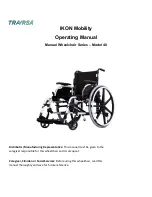
22
DIETZ GmbH / User manual adaptive wheelchair AS[01 | AS[01]RF / Version 3.0.0 EN
04 USING THE WHEELCHAIR
4.7 Using the wheelchair on inclines,
slopes, steps and edges
Before you drive up or down gradients/steps and
edges with your wheelchair, you should practice
with an attendant. In these driving situations, the
tipping risk is increased, which is why DIETZ rec-
ommends the use of anti-tipping supports for
inexperienced drivers. The braking power is sig
-
nificantly lower in such driving conditions as
compared to on even ground. Potholes, moisture,
snow, grit and dirt can also cause the wheelchair
to tip over in these situations.
When driving up inclines and up a step/edge,
lean your upper body forward (1,2, Fig. 18).
When driving down slopes and down a step/edge,
lean your upper body backwards (3,4, Fig. 18)
WARNING
Never drive down slopes and steps/edges with
-
out braking, only at reduced speed.
WARNING
Stairs with more than two steps must be driven
with the support of an attendant.
WARNING
Never try to drive up/down inclines or gradients
diagonally.
Fig. 18
1
10˚
2
10˚
3
4
WARNING
The stability on slopes/gradients depends on
the configuration of the wheelchair, the skills
and the driving style of the user. Since the user's
skills and driving style cannot be predeter
-
mined, the maximum safe descent gradient
cannot be determined. This must be determined
by the user with the help of an attendant in or-
der to prevent tipping over.
For inexperienced users, the installation of an-
ti-tipping supports is strongly recommended.

![Предварительный просмотр 8 страницы Dietz Rehab AS[01] User Manual](http://thumbs.mh-extra.com/thumbs/dietz-rehab/as-01/as-01_user-manual_2495939-08.webp)
![Предварительный просмотр 9 страницы Dietz Rehab AS[01] User Manual](http://thumbs.mh-extra.com/thumbs/dietz-rehab/as-01/as-01_user-manual_2495939-09.webp)
![Предварительный просмотр 10 страницы Dietz Rehab AS[01] User Manual](http://thumbs.mh-extra.com/thumbs/dietz-rehab/as-01/as-01_user-manual_2495939-10.webp)
![Предварительный просмотр 11 страницы Dietz Rehab AS[01] User Manual](http://thumbs.mh-extra.com/thumbs/dietz-rehab/as-01/as-01_user-manual_2495939-11.webp)
![Предварительный просмотр 12 страницы Dietz Rehab AS[01] User Manual](http://thumbs.mh-extra.com/thumbs/dietz-rehab/as-01/as-01_user-manual_2495939-12.webp)
![Предварительный просмотр 13 страницы Dietz Rehab AS[01] User Manual](http://thumbs.mh-extra.com/thumbs/dietz-rehab/as-01/as-01_user-manual_2495939-13.webp)
![Предварительный просмотр 14 страницы Dietz Rehab AS[01] User Manual](http://thumbs.mh-extra.com/thumbs/dietz-rehab/as-01/as-01_user-manual_2495939-14.webp)
![Предварительный просмотр 15 страницы Dietz Rehab AS[01] User Manual](http://thumbs.mh-extra.com/thumbs/dietz-rehab/as-01/as-01_user-manual_2495939-15.webp)
![Предварительный просмотр 16 страницы Dietz Rehab AS[01] User Manual](http://thumbs.mh-extra.com/thumbs/dietz-rehab/as-01/as-01_user-manual_2495939-16.webp)
![Предварительный просмотр 17 страницы Dietz Rehab AS[01] User Manual](http://thumbs.mh-extra.com/thumbs/dietz-rehab/as-01/as-01_user-manual_2495939-17.webp)
![Предварительный просмотр 18 страницы Dietz Rehab AS[01] User Manual](http://thumbs.mh-extra.com/thumbs/dietz-rehab/as-01/as-01_user-manual_2495939-18.webp)
![Предварительный просмотр 19 страницы Dietz Rehab AS[01] User Manual](http://thumbs.mh-extra.com/thumbs/dietz-rehab/as-01/as-01_user-manual_2495939-19.webp)
![Предварительный просмотр 20 страницы Dietz Rehab AS[01] User Manual](http://thumbs.mh-extra.com/thumbs/dietz-rehab/as-01/as-01_user-manual_2495939-20.webp)
![Предварительный просмотр 21 страницы Dietz Rehab AS[01] User Manual](http://thumbs.mh-extra.com/thumbs/dietz-rehab/as-01/as-01_user-manual_2495939-21.webp)
![Предварительный просмотр 22 страницы Dietz Rehab AS[01] User Manual](http://thumbs.mh-extra.com/thumbs/dietz-rehab/as-01/as-01_user-manual_2495939-22.webp)
![Предварительный просмотр 23 страницы Dietz Rehab AS[01] User Manual](http://thumbs.mh-extra.com/thumbs/dietz-rehab/as-01/as-01_user-manual_2495939-23.webp)
![Предварительный просмотр 24 страницы Dietz Rehab AS[01] User Manual](http://thumbs.mh-extra.com/thumbs/dietz-rehab/as-01/as-01_user-manual_2495939-24.webp)
![Предварительный просмотр 25 страницы Dietz Rehab AS[01] User Manual](http://thumbs.mh-extra.com/thumbs/dietz-rehab/as-01/as-01_user-manual_2495939-25.webp)
![Предварительный просмотр 26 страницы Dietz Rehab AS[01] User Manual](http://thumbs.mh-extra.com/thumbs/dietz-rehab/as-01/as-01_user-manual_2495939-26.webp)
![Предварительный просмотр 27 страницы Dietz Rehab AS[01] User Manual](http://thumbs.mh-extra.com/thumbs/dietz-rehab/as-01/as-01_user-manual_2495939-27.webp)
![Предварительный просмотр 28 страницы Dietz Rehab AS[01] User Manual](http://thumbs.mh-extra.com/thumbs/dietz-rehab/as-01/as-01_user-manual_2495939-28.webp)
![Предварительный просмотр 29 страницы Dietz Rehab AS[01] User Manual](http://thumbs.mh-extra.com/thumbs/dietz-rehab/as-01/as-01_user-manual_2495939-29.webp)
![Предварительный просмотр 30 страницы Dietz Rehab AS[01] User Manual](http://thumbs.mh-extra.com/thumbs/dietz-rehab/as-01/as-01_user-manual_2495939-30.webp)
![Предварительный просмотр 31 страницы Dietz Rehab AS[01] User Manual](http://thumbs.mh-extra.com/thumbs/dietz-rehab/as-01/as-01_user-manual_2495939-31.webp)
![Предварительный просмотр 32 страницы Dietz Rehab AS[01] User Manual](http://thumbs.mh-extra.com/thumbs/dietz-rehab/as-01/as-01_user-manual_2495939-32.webp)
![Предварительный просмотр 33 страницы Dietz Rehab AS[01] User Manual](http://thumbs.mh-extra.com/thumbs/dietz-rehab/as-01/as-01_user-manual_2495939-33.webp)
![Предварительный просмотр 34 страницы Dietz Rehab AS[01] User Manual](http://thumbs.mh-extra.com/thumbs/dietz-rehab/as-01/as-01_user-manual_2495939-34.webp)
![Предварительный просмотр 35 страницы Dietz Rehab AS[01] User Manual](http://thumbs.mh-extra.com/thumbs/dietz-rehab/as-01/as-01_user-manual_2495939-35.webp)
![Предварительный просмотр 36 страницы Dietz Rehab AS[01] User Manual](http://thumbs.mh-extra.com/thumbs/dietz-rehab/as-01/as-01_user-manual_2495939-36.webp)
![Предварительный просмотр 37 страницы Dietz Rehab AS[01] User Manual](http://thumbs.mh-extra.com/thumbs/dietz-rehab/as-01/as-01_user-manual_2495939-37.webp)

















